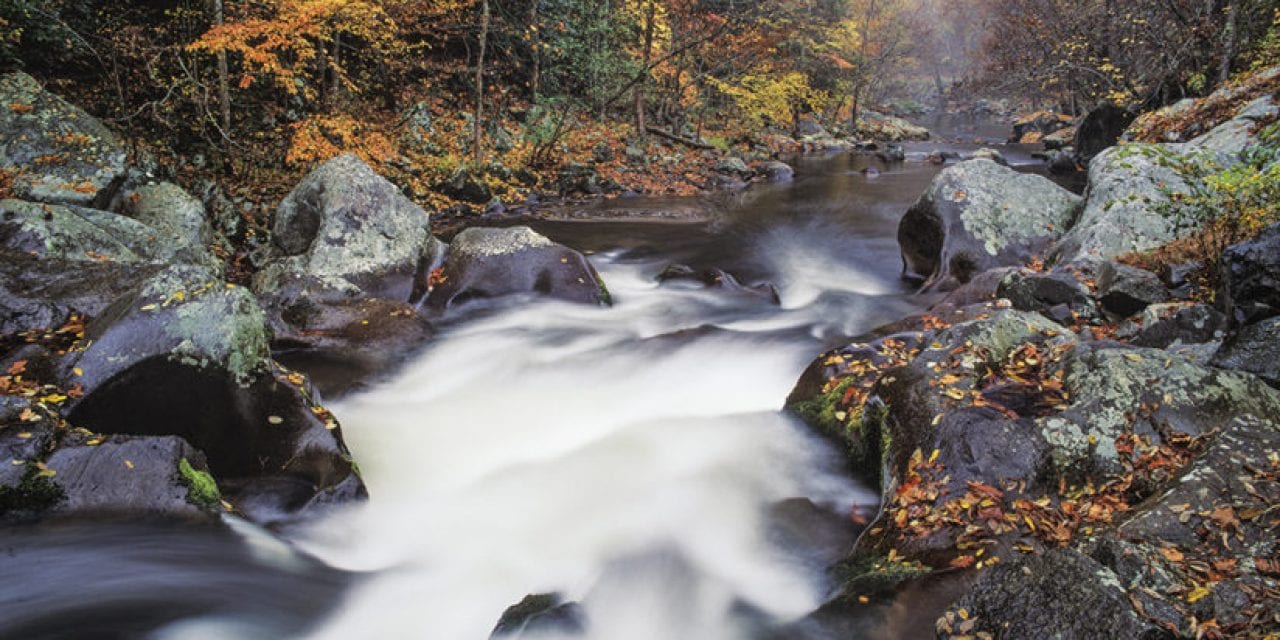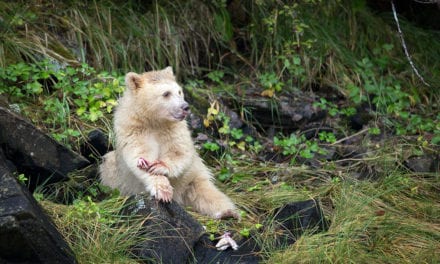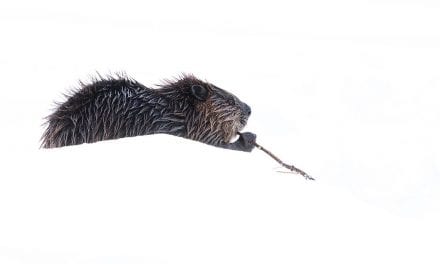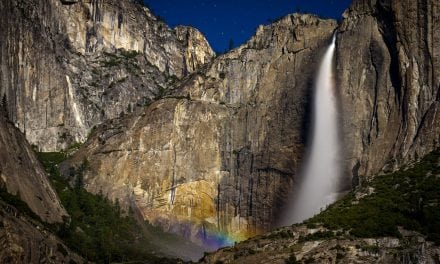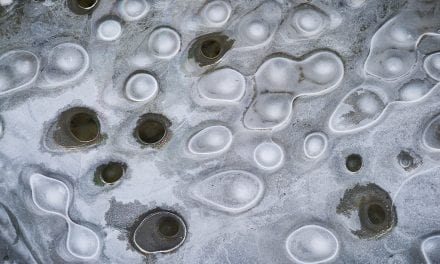Like most photographers, I’m looking forward to and planning for fall photography, the cooler weather the season brings, and—most importantly—the colorful displays of nature before winter sets in. Fall colors can be so impressive, it really doesn’t matter where you go; there are many great locations to explore. Every photographer has his or her favorite fall color photo locations, though, and these are some of mine.
Great Smoky Mountains National Park
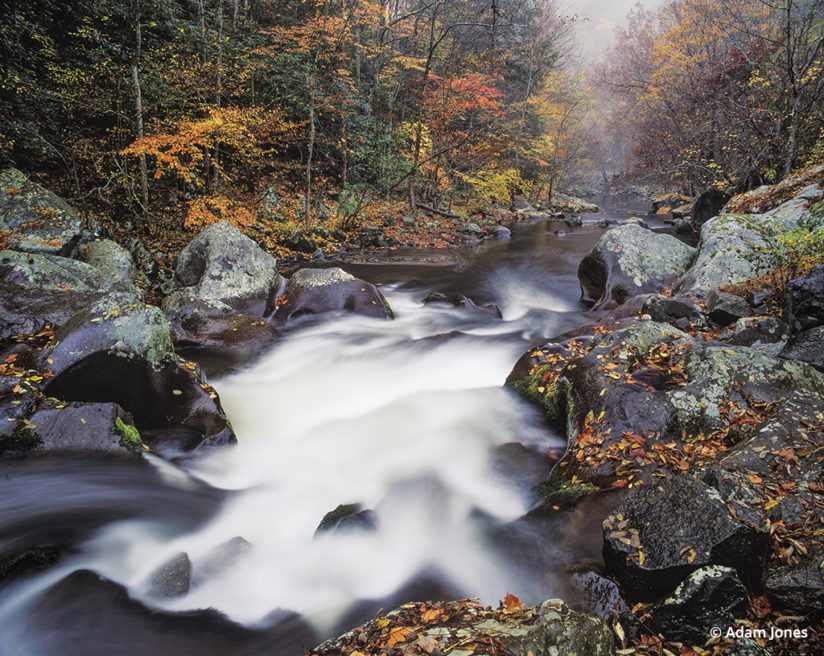
This destination is a no-brainer for me. It’s an easy five-hour drive from my hometown near Louisville, Kentucky. The Smokies straddle the North Carolina and Tennessee border. Don’t come to the southern mountains expecting flaming red colors rivaling New England, as the colors here are bit less vibrant than in the north. Nonetheless, the photo opportunities are remarkable. The Smokies offer great variety of scenes and subjects, including plunging valleys, mountain vistas, historic cabins, barns, rushing streams, waterfalls and pastoral scenes in Cades Cove.
The best locations for grand vistas are high up the mountain and right on the side of the main park road, U.S. Route 441. My favorite locations include Morton Overlook, which is the best westward-facing view with easy access by car. Note, however, that the sun does not set in the valley below during the fall season. This location can be good for morning fog mixed with fall colors.
At Newfound Gap, just before crossing into North Carolina, there is a large parking area with limited vistas. Following Route 441 east and descending into North Carolina, the view on your right is some of the best in the eastern U.S. Here you’ll find a series of overlooks facing south with spectacular views of Deep Creek Valley. This area can be good in both the mornings and evenings in the fall.
The park is blessed with numerous rushing streams and rivers flowing beneath a canopy of mature hardwoods displaying their colors. Some of the best include Little River along Little River Road on the way to Cades Cove, Little Pigeon River, Middle Prong of Little River and Big Creek.
The timing of “peak” fall color is never an exact science. Usually the peak in this area is from the third week in October into the first week of November. Peak color can vary a week or so in either direction, so it’s best to check before going. If you are early, work the higher elevations; if you are late in the season, check out Cades Cove for the last remaining color.
Cades Cove is on my must-see list during any season. If planning a visit, know there is a gate restricting entry by vehicle until sunrise. Visitors start lining up in their cars at the gate an hour before sunrise, so plan on arriving very early and waiting in your car in line until the ranger opens the gate. If you can’t be there very early, I would skip Cades Cove. By mid-morning, the 11-mile loop road turns into a parking lot, and it requires several hours to make the loop through this beautiful pastoral setting.
The most centrally located lodging for the Smokies is in Gatlinburg, Tennessee. I prefer hotels located very near the park entrance for easy access in and out of Gatlinburg, which can be very crowded in fall. Get out very early, and the crowds are not usually a problem, but returning to Gatlinburg at dinner time can be a traffic headache.
Blue Ridge Parkway
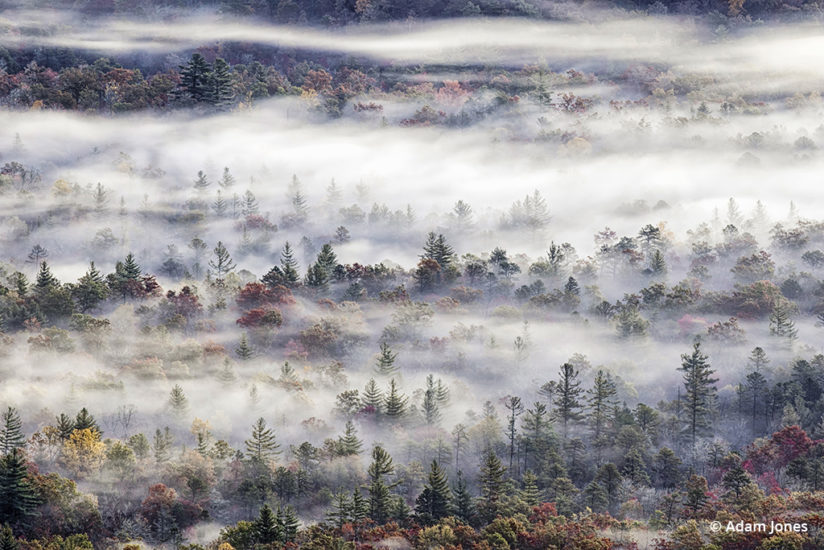
The Travel Channel recently featured the Blue Ridge Parkway as one of the best fall foliage road trips in the country, and it is one of my favorites as well. The Parkway actually terminates at the Great Smoky Mountains National Park, meaning you can easily photograph the Smokies and then explore northward on the Parkway on the same trip.
Brevard, North Carolina, provides an excellent base from which to explore. This artsy small town has great restaurants and lodging. Just out of town is the DuPont State Forest, home to Hooker Falls and other great waterfalls surrounded by a colorful hardwood forest. High Falls, Triple Falls and Bridal Veil Falls are interesting destinations, if you don’t mind hiking. The DuPont State Forest is also conveniently located about 40 miles from Asheville, North Carolina.
Just out of Brevard on your way to the Parkway on U.S. Route 276 you pass Looking Glass Falls in the Pisgah National Forest. It’s about 35 steps down from the roadside parking to the viewing area at the base of this 60-foot waterfall. Also on Route 276 is the Cradle of Forestry, an American Heritage Site. Here you’ll find restored cabins, an old schoolhouse, rail fences and wooden wagons.
The Parkway uses a milepost system to identify points of interest along the 469-mile route, spanning Virginia and North Carolina. My favorite sunrise location is at Pounding Mill Overlook, located at Milepost 413.2. Here you have a commanding view from an elevation of 4,700 feet. Morning fog often fills the valleys below and fall colors grace the mountain slopes higher up. The best sunset location is at Cowee Mountain Overlook, Milepost 430.7 at an elevation of 5,950. Here you have a sweeping, classic view of the Blue Ridge Mountains.
For me, morning is far and away the best time to photograph the Blue Ridge. Nature often puts on its most spectacular light shows at first light, especially when there is fog in the valleys or clouds rolling over mountain ridges like waterfalls. If it’s foggy and rainy, don’t despair—there are tons of photo opportunities to frame fall colors against foggy backgrounds. Or venture into the forest for more intimate scenes. Macro photography is outstanding on foggy and rainy days. If you can find the awe and wonder in small subjects, you will never run out of interesting things to photograph.
The best time to visit is from the end of September to the end of October. Allow for plenty of travel time between mileposts as there is lots to see and photograph.
New Hampshire
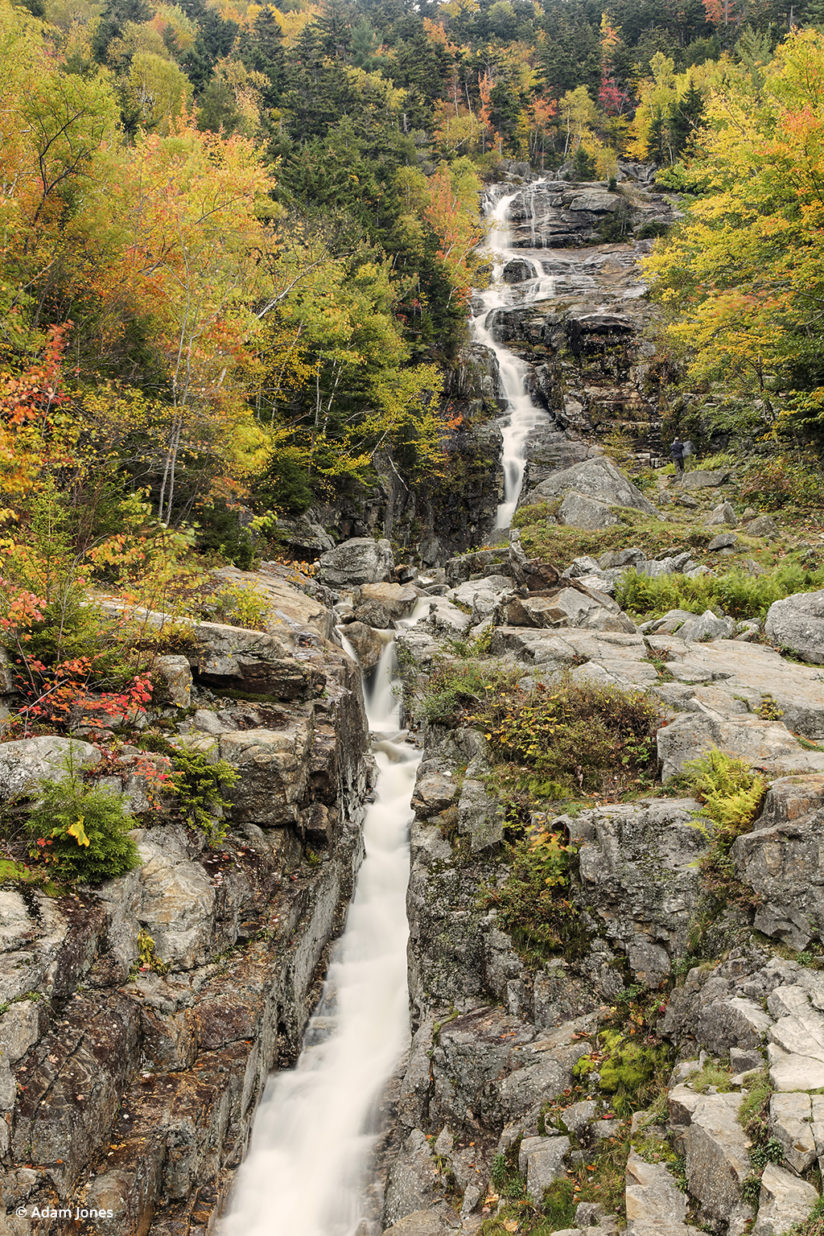
Mention fall colors and New Hampshire instantly comes to mind. Many consider the Kancamagus Highway the best fall scenic drive in New England. Also known as New Hampshire Route 112, this National Scenic Byway runs 22 miles through the White Mountains from Lincoln to Conway and certainly delivers on those expectations. Photographers from all around the country descend upon this area every fall. The White Mountains at peak color are hard to beat; the air is crisp and clean, and the north woods are rich with vibrant reds and yellows. Fall color usually peaks around late September to the first week in October.
My favorite area is the Swift River, running right alongside the scenic byway. The river flows and cascades over boulders and beneath scenic covered bridges in typical New England charm. The river is at its best on cloudy, drizzly days, when the colors are super saturated, the light is soft and rocks in the river are wet. Lower falls is one of the more scenic cascades in the Swift River, flowing over large granite boulders.
My favorite pond for a larger scenic is Beaver Pond. Mornings before 9 a.m. offer the best lighting, and on calm days, the reflection is crystal clear. Access is very easy for beginners, and pros will enjoy the many variations to be found with a bit more visual exploration. From Woodstock, New Hampshire (not Woodstock, Vermont), travel 3.9 miles on Route 112.
Lily Pond is 18 miles west of Conway right off the Kancamagus Highway and is a very popular photography destination. Here a beautiful small pond is surrounded by mountains draped in fall splendor. On a calm day, the reflections on the pond are spectacular.
You may explore the Kancamagus Highway in either direction. I usually prefer exploring from east to west, starting in Conway. The advantage of traveling east to west is there’s a good opportunity to explore Franconia Notch, home to Flume Gorge. The gorge is located at the base of Mount Liberty in Franconia Notch State Park, near Lincoln. The area features a plunging gorge with a boardwalk for safe access, waterfalls and curving cascades carved deep into the rocks.
From Lincoln, you can also travel north about 30 miles on scenic U.S. Route 302 to Crawford Notch State Park. Here you’ll find Silver Cascade, truly a roadside waterfall. This must be one of the most-photographed waterfalls in the country. Note that this area can be quite crowded with tourists and photographers alike, so it’s best to visit in the very early morning before the crowds arrive.
These areas all deserve more exploration than a single trip will ever reveal, but also consider getting off the well-traveled roads and investigate some of the back roads. There is beautiful scenery everywhere.
Michigan’s Upper Peninsula
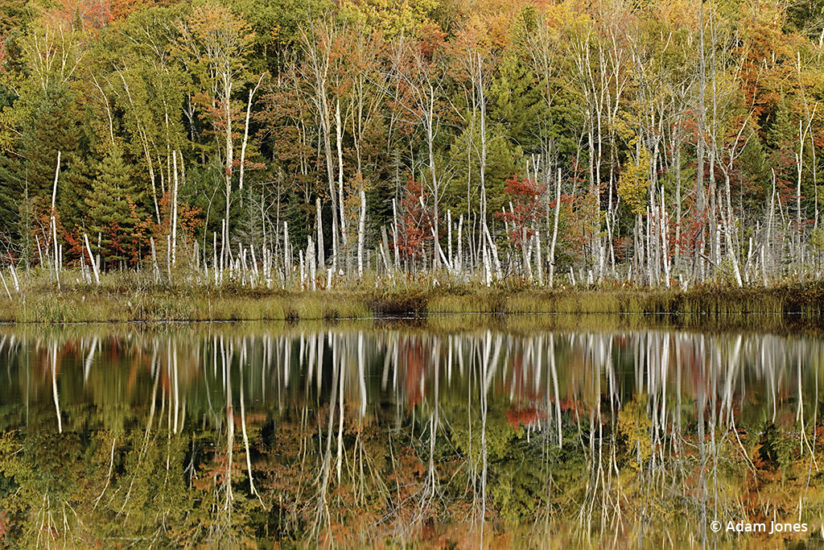
The “U.P.” or Upper Peninsula of Michigan is a photographer’s paradise. There are sandstone cliffs, beaches, sand dunes, waterfalls, inland lakes, north woods and a wild shoreline to explore. Lake Superior wields its influence on the park’s shore areas and areas much further inland, creating unique and varied landscape for photography.
For me, the U.P. consists of three main areas to explore. The most obvious is the shoreline cliffs and beaches of Pictured Rocks National Lakeshore, a distinct area of its own. The shoreline of Lake Superior can be traveled on land in many areas or via guided tour boats. The best views of the 200-foot high cliffs are from a boat, which operates daily, weather permitting. Exploring from land is quite rewarding as waterfalls cascade off cliffs, waves crash against the shoreline with tremendous energy, and fall colors adorn the intersection of land and water.
With a week to spend, try working out of two different locations. The first is Munising, with very good access to the National Lakeshore, waterfalls and some of the best lakes surrounded by north woods and fall colors. My good friend John Dykstra introduced me to the U.P. a few years ago, and I was hooked. Some of our first adventures began around Red Jack Lake, Council Lake, Irwin Lake and Thornton Lake in the Hiawatha National Forest.
Red Jack Lake is surrounded by a squishy bog of Sphagnum moss, and you are actually walking and shooting from a floating mass of vegetation. Yes, you can carefully set up a tripod, and it’s best if you have rubber boots or water shoes in some places around the shoreline. Deep purple-colored northern pitcher plants practice their carnivorous lifestyle in the many bogs.
I guess I’m just a morning photographer, but once again these lakes are best at sunrise, as they are usually calm with reflections, and a light morning mist just adds to the tranquil mood. One of the best things about the U.P. is that it is not overrun with visitors. This area is one of the best-kept secrets in the nation. Plan to be on location around Oct. 10.
The Hiawatha National Forest surrounding Munising is simply an amazing example of pristine north woods. The forest understory is open and clean, blueberry foliage is red, pines and hardwoods mix for great color combinations, reindeer lichen carpets the forest floor, and golden ferns rise above in great profusion. The macro possibilities on and around the forest floor are stunning, even better when there are dewdrops or raindrops clinging to everything.
About 98 miles east of Munising is Paradise, a great location to headquarter your second stage of exploration. A must-see is Tahquamenon Falls at Tahquamenon Falls State Park in Paradise. It is one of the largest waterfalls east of the Mississippi, some 200 feet wide with a 50-foot drop. The water here is tea-colored from the tannins leached from the cedar swamps, which the river drains. The falls are best visited on a cloudy day, or better yet a day with very light drizzle. There are actually two sets of falls on the Tahquamenon River: Upper Falls, the larger main waterfall, and Lower Falls, located 4 miles down-river. The lower falls consists of five smaller falls cascading around an island that is easily accessible by rowboat. Once on the island, a short hiking trail runs along the riverside, offering great views. Further downstream the river becomes more placid and offers great morning scenes of steam rising along banks covered in red ferns.
Nearby is Whitefish Point Lighthouse, good for another scenic point of interest. Look for reflections in the windows and the brightly colored red rooftops. The lakeshore beaches here are covered in colorful rounded smooth stones. These are wonderful for natural pattern images.
Acadia National Park
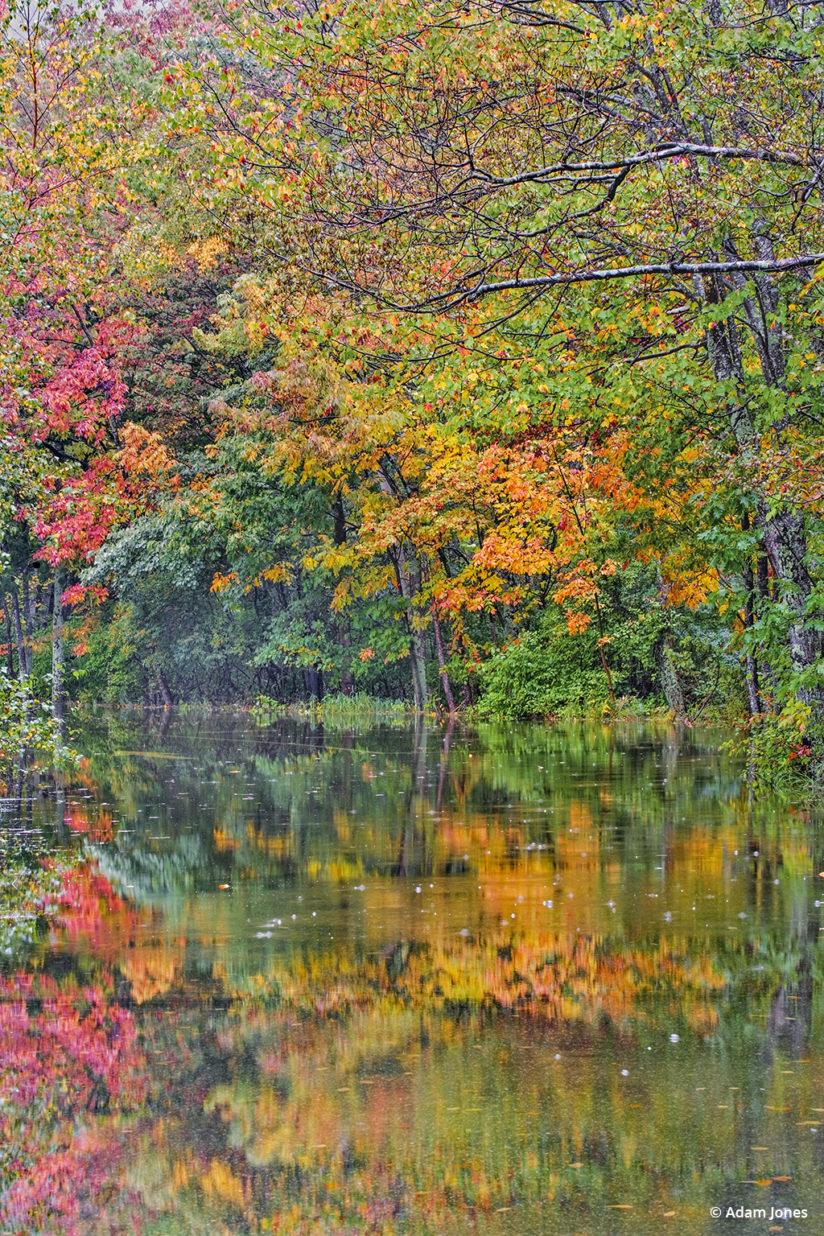
With its dramatic meeting of land and sea, Acadia National Park is a photographer’s dream any time of year. Throw in crisp, cool autumn air, spectacular fall colors, rugged coastline, lakes and ponds, and it’s impossible to go wrong, photographically speaking. Keep in mind that peak fall color is usually around mid-October, but like anywhere else, the exact peak may vary. (You can check current conditions at mainefoliage.com.) Peak color seems a bit late in the season for such a northern location, which is due to the ocean moderating coastal temperatures, delaying peak color compared to more inland locations.
Regardless of what the fall colors are doing, the coastline in the park is simply stunning. Pink granite boulders rise against the relentless pounding of the ocean waves. The best beaches are on the east side of Mount Desert Island and are spectacular at sunrise. Ocean Path is an easy trail right along the main road, following a dramatic stretch between Sand Beach and Otter Point. Landmarks you’ll encounter include Sand Beach, Thunder Hole, Monument Cove and Otter Cliff. Otter Cliff is a very popular backdrop. This area can be quite crowded at sunrise during peak times, with photographers jockeying for the best angle on the bowling-ball-sized rocks on the beach, so arrive plenty early.
Cadillac Mountain is the tallest mountain on Mount Desert Island. The summit of it is said to receive the very first light that strikes the U.S., and is an extremely popular location at sunrise. The parking lot at the top is often full, so again, go very early, or skip it and explore further inland away from the crowds. The view at sunrise is stunning, with pink granite rocks dotting the landscape among wild blueberry foliage displaying rich red autumn color.
Jordan Pond and Bubble Pond are well-known destinations and certainly worth your visit. Hiking trails afford plenty of access around these two ponds, and a short trek of 800 feet rewards you with sweeping views of Eagle Lake and Jordan Pond, surrounded by breathtaking fall colors.
Bass Harbor Head Lighthouse is another must-see destination within the park. This lighthouse is one of the most photogenic lights in New England. This attraction can be photographed at sunrise or sunset. The lighthouse is about 18 miles from Bar Harbor on the south side of Mount Desert Island, just off Maine State Route 102A.
Roughly halfway between Bass Harbor Head Lighthouse and Seawall on Route 102A is the Wonderland Trail. This area is level compared to the rest of Acadia. The trail is an old abandoned road heading toward the ocean. On the way, you pass through pines and large flat areas covered in wild blueberry foliage displaying brilliant red leaves. At the ocean, there are tide pools to explore on this quieter side of the island.
Acadia has way more than enough to satisfy most photographers, and I’ve merely touched on the big obvious locations. Get out and explore on your own via the carriage paths and numerous hiking trails, and you won’t be disappointed.
Although not part of the park, Breakneck Ponds often have great fall color around the shoreline and reflections for wide-angle scenic images. These ponds are located just a few minutes out of Bar Harbor off Maine State Route 233. From Bar Harbor go west on Route 233 to the northern tip of Eagle Lake near Eagle Lake Bridge. From here there is a short hiking path north to Breakneck Ponds.
Colorado’s San Juan Mountains
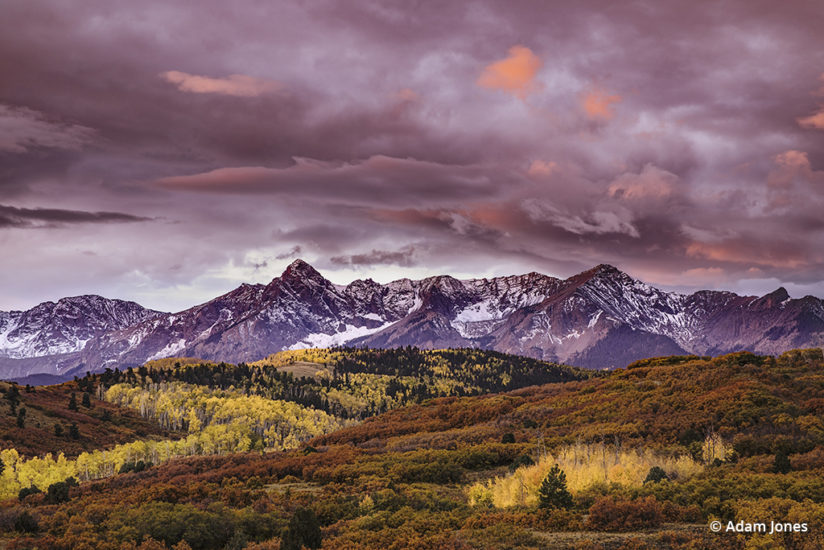
Colorado is especially breathtaking, with towering mountains rising dramatically with golden aspen trees blanketing slopes. The San Juan Mountains are stunning and easily accessible from Ouray, Colorado. Aptly described, Ouray calls itself the “Switzerland of America.”
About 6.3 miles south of Ouray toward Silverton on U.S. Route 550 (the “Million Dollar Highway”) is Crystal Lake. Some find the road to be scary, with huge drop offs and no guardrails, so keep your eyes on the road driving up this steep, curvy section. Crystal Lake is great for a sunrise reflection of two mountains covered with aspens on surrounding slopes. Arrive early and go toward the far side of the dam for the best views. It may take a few tries at this lake to get a calm morning for a pristine reflection. This is also a great location for classic white aspen trunks surrounded by golden leaves, also at the far end of the dam.
Continuing south on Route 550 is Ironton, a ghost town on the left side of the road. Several abandoned buildings offer lots of photographic possibilities. Continuing on another 5 miles brings you to Red Mountain Pass at 11,008 feet, providing views of mines, red slopes and rust-colored mine tailings. This area is best in late afternoon light.
You could drive Route 550 for many more miles, but I usually turn around at Red Mountain Pass and start working my way back toward Ridgeway and exploring areas west on Colorado State Highway 62, which runs from Ridgeway to Placerville. County roads from this highway lead to tremendous views of Mt. Sneffels and the Uncompahgre National Forest. Highway 62 is paved, but many of the side roads require a higher-clearance vehicle, and possibly 4-wheel drive after a rain.
The first road you come to in Ridgeway is County Road 5 (Girl Scout Camp Road). Follow this road as far as you can. It crosses private property, so stay on the road until in the national forest. This road is less well-known and less busy than County Road 7 and County Road 9. This is classic Colorado in the fall, with huge aspen stands and soaring mountains.
Approximately 5 miles out of Ridgeway, turn left onto County Road 7. Check out the pond on the left for a view of Mt. Sneffels. The pond is on private land, so please stay on the road.
County Road 9 is 6 miles from Ridgeway. Turn left once again and follow the road for about another 6 miles. The road crosses the Double RL Ranch owned by Ralph Lauren, so again, do not venture off the road until in the Uncompahgre National Forest.
Dallas Divide is a wonderful stop for sweeping vistas of the Sneffels Range. It is a large parking area about 10.5 miles west of Ridgeway on Highway 62. Sunrise and sunset are the best times to capture this classic view. Stay behind the wooden rail fence—property on the other side of the fence is private.
I’ve said it several times, but it bears repeating: Please be respectful of all private property. Photographers in some areas, such as the Palouse, are wearing out their welcome by having little or no regard for private property of others. Please don’t be one of those photographers.
Yellowstone National Park
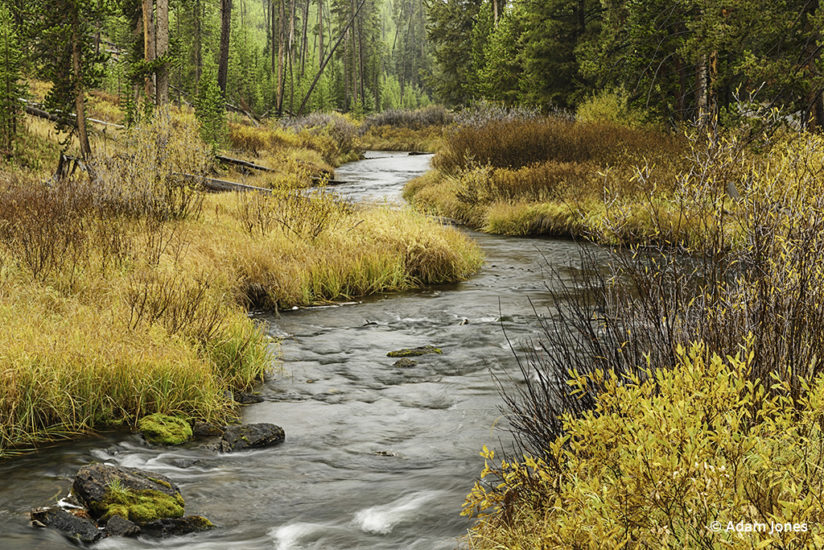
Yellowstone is often overlooked as a great fall destination, but it is really spectacular in a different way than the other locations I’ve mentioned here. My favorite time to visit is in mid-to-late September. In terms of color, there are indeed patches of yellow aspens and cottonwood trees, but the grassy meadows and thermal features are the attraction. The grasses and reeds in the meadows turn gold and red in mid-September. The ground foliage is quite spectacular in its own right.
Autumn temps overnight can be quite cool, perfect for generating ethereal steam clouds from the warm waters and geothermal features. The fog and steam add a magical ambiance to the meadows, streams and trees, affording us limitless opportunity to explore creative landscapes. Elk, bison, wolves, coyotes and bear are in their prime and make great portraits or parts of larger landscape images. Dew and frost sparkle and refract the morning light across the meadows and spider webs glisten. The hardest thing may be deciding how to split your time between photographing wildlife or landscapes. With a little luck, an early dusting of snow transforms the park’s scenic possibilities.
The park is so large you may want to consider lodging in two or more locations. I like West Yellowstone outside the park at the west entrance. Here there are plenty of lodging and restaurants once shooting is done for the day. From West Yellowstone, the pullout at Madison Junction near the campground is a great meadow for steaming sunrises along the Madison River. The resident elk herd here can be very cooperative and active around sunrise. This corner has been a favorite of mine for many years.
Gardiner on the north entrance is a great location for exploring the areas around Mammoth Hot Springs, Tower-Roosevelt and Lamar Valley further toward the northeast entrance.
Old Faithful Inn is a favorite for families and located inside the park, but reservations need to be made a year in advance. Be sure to see an Old Faithful eruption, especially if you have a dramatic sky behind this much-photographed icon.
The Grand Canyon of Yellowstone is another iconic place for landscape photography. The best time in the fall is at sunrise. The canyon walls offer great patterns to be extracted by the observant photographer with a telephoto lens. One year, my workshop group was met with a huge male black bear right on the sidewalk at the overlook. Of course, we knew who had to yield in this situation.
I never tire of Yellowstone. The interaction of light, the steam, vibrant colors and large animals in abundance are intoxicating. Even if the fall colors in the meadows mysteriously failed to materialize, tons of other subjects in this jewel of a park beckon to be photographed. The thermal features alone offer tremendous colors, patterns and textures any season or time of day.
My Tips For Fall Color Photos
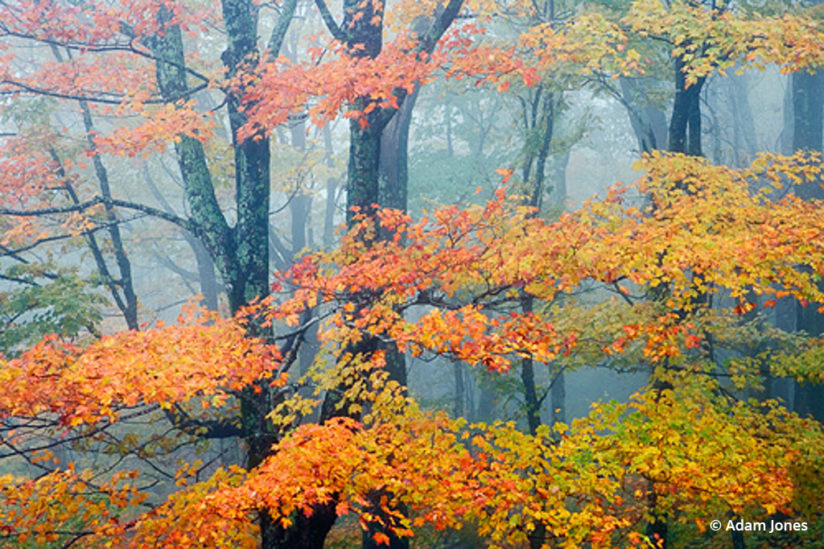
Great fall color images can be made in any kind of light, from bright sun to overcast skies and rain. Adjust your shooting to accommodate the lighting encountered. After all, we are “painting with light,” so use it to the best effect. For example, if the sky is white and featureless, simply compose without any sky.
Always consider the direction of your lighting and how it impacts important elements of your composition. Try backlighting leaves or other colorful subjects for a different look, and vary your exposure greatly for dramatically backlit subjects.
I nearly always use a tripod for landscapes and the lowest ISO that will get the job done. If the wind is moving the leaves in your scene, avoid longer exposures—unless you are looking for a motion blur effect. If there is a troublesome breeze, push the ISO higher to allow for shorter shutter speeds to counteract movement and blurry leaves. I would rather use a higher ISO and freeze any motion than use the lowest ISO and have blurry images.
Most of the time, my lenses have polarizers on them. This filter saturates the colors of most scenes, removing shiny glare that reduces color transmission. The filter is especially effective around waterfalls, wet leaves and rocks, and wider scenic images. Just be careful on crystal clear blue-sky days. When using a very wide lens, only a portion of the sky is polarized. Usually, one corner of the sky is very dark blue and the other corner is normal. Unevenness in the sky is very unnatural looking in the finished image. A polarizing filter is also very effective on wet cloudy days, again removing subtle reflections from wet rocks and foliage.
Train yourself to be open to all the possibilities available at any given time. Try shooting straight up through the trees. Look down on the ground at the almost limitless opportunities for macro photography during the fall season. Leaf patterns on the ground, mushrooms, ferns, pinecones, rocks, lichen, grasses, frost, dew—all are amazing subjects if we take the time to observe them closely.
See more of Adam Jones’s work at adamjonesphoto.com.
YOU MIGHT ALSO LIKE
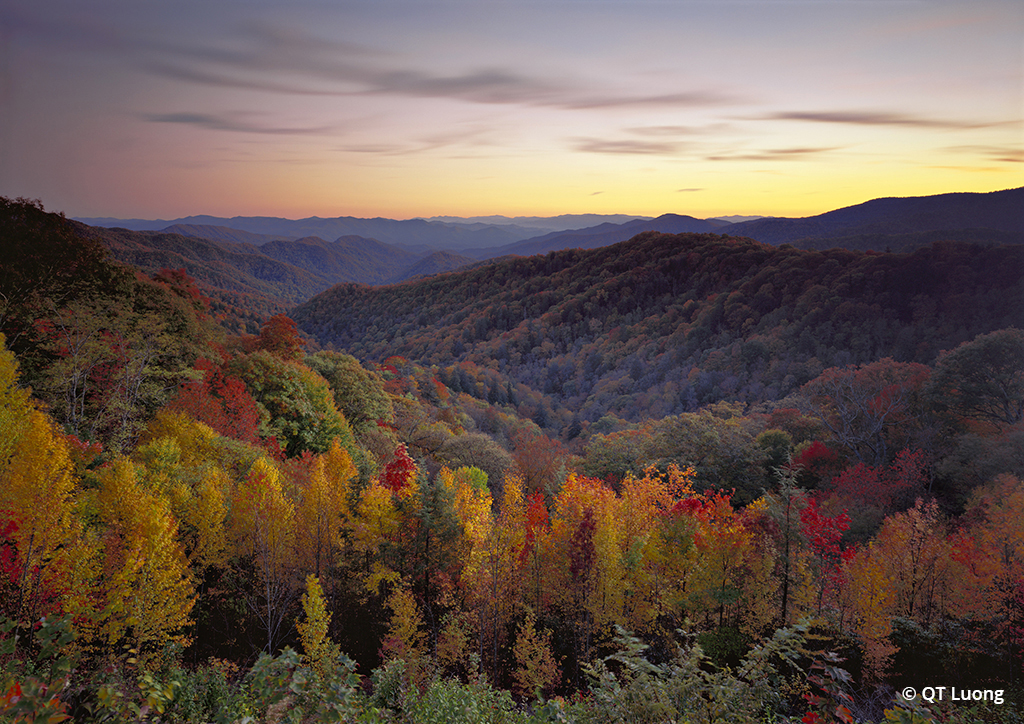
10 National Parks For Fall Foliage
Favorite national parks to find vibrant fall color — and it’s not just the parks you’d expect. Read now.
The post Favorite Fall Color Photo Locations appeared first on Outdoor Photographer.

